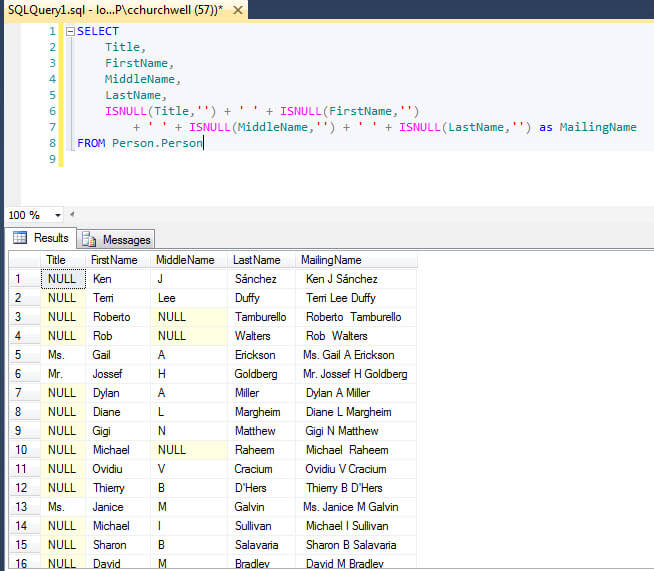
#SQL SERVER CONCAT HOW TO#
Here’s the same result set but without the STRING_AGG() function: SELECT Genre AS Resultįor more examples, such as grouping, handling null values, and ordering the results, see How to Return Query Results as a Comma Separated List in SQL Server. This is because our second argument is a comma, which specifies that a comma should be used as the separator. Rock,Jazz,Country,Pop,Blues,Hip Hop,Rap,PunkĪs you can see, the result set is listed out as a comma separated list. Here’s a quick example of the STRING_AGG() function: SELECT STRING_AGG(Genre, ',') AS Result DESC orders the result in descending order. ASC orders the result in ascending order. The (optional) order clause consists of WITHIN GROUP followed by ORDER BY ASC or ORDER BY DESC in parentheses. Ways to compare and find differences for SQL Server tables and data. Where separator is an exprssion of NVARCHAR or VARCHAR type that is used as separator for concatenated strings. Concatenate SQL Server Columns into a String with CONCAT() How to Get Current Date in SQL Server. Non-string types are converted to NVARCHAR type. Expressions are converted to NVARCHAR or VARCHAR types during concatenation. Where expression is an expression of any type.

The syntax of the STRING_AGG() function goes like this: STRING_AGG ( expression, separator ) This function does pretty much the same thing as MySQL’s GROUP_CONCAT() function (with some minor differences). However, T-SQL now has the STRING_AGG() function which is available from SQL Server 2017.

Prior to SQL Server 2017, if you wanted to put your result into a comma separated list, you’d need to find a workaround, perhaps using a combination of STUFF(), FOR XML, and PATH(). This function allows you to return a result set as a comma-separated list, as opposed to listing each row as a separate row (as with a normal result set). In SQL Server (Transact-SQL), the + operator allows you to concatenate 2 or more strings together. NULL is '' (empty string), does not depend on CONCAT. If any value is NULL, the result is NULL, unless CONCATNULLYIELDSNULL is OFF. This allows you to provide the string and the number as two separate arguments. You can convert Oracle string concatenation operator to + operator or CONCAT function in SQL Server and SQL Azure: + Operator. The most obvious (and possibly the best) way to concatenate a string and a number is to use the CONCAT() function.

This article presents six ways to concatenate strings with numbers using T-SQL. Raj is always interested in new challenges so if you need consulting help on any subject covered in his writings, he can be reached at all posts by Rajendra GuptaBefore SQL Server 2017 came along, there wasn’t a T-SQL equivalent of the MySQL GROUP_CONCAT() function. This SQL Server tutorial explains how to use the concatenate operator (+ operator) in SQL Server (Transact-SQL) with syntax and examples. Fortunately SQL Server/T-SQL makes this a breeze. Based on his contribution to the SQL Server community, he has been recognized with various awards including the prestigious “Best author of the year" continuously in 20 at SQLShack. An operator in a string expression that concatenates two or more character or binary strings, columns, or a combination of strings and column. When moving SQL script files between systems having different character sets.
#SQL SERVER CONCAT SERIES#
He is the creator of one of the biggest free online collections of articles on a single topic, with his 50-part series on SQL Server Always On Availability Groups. The concatenation operator manipulates character strings and CLOB data. He is the author of hundreds of authoritative articles on SQL Server, Azure, MySQL, Linux, Power BI, Performance tuning, AWS/Amazon RDS, Git, and related technologies that have been viewed by over 10m readers to date. As an MCSA certified and Microsoft Certified Trainer in Gurgaon, India, with 13 years of experience, Rajendra works for a variety of large companies focusing on performance optimization, monitoring, high availability, and disaster recovery strategies and implementation.


 0 kommentar(er)
0 kommentar(er)
